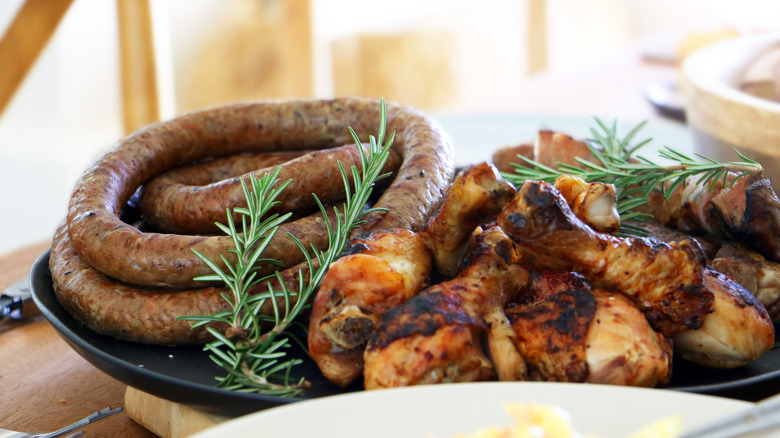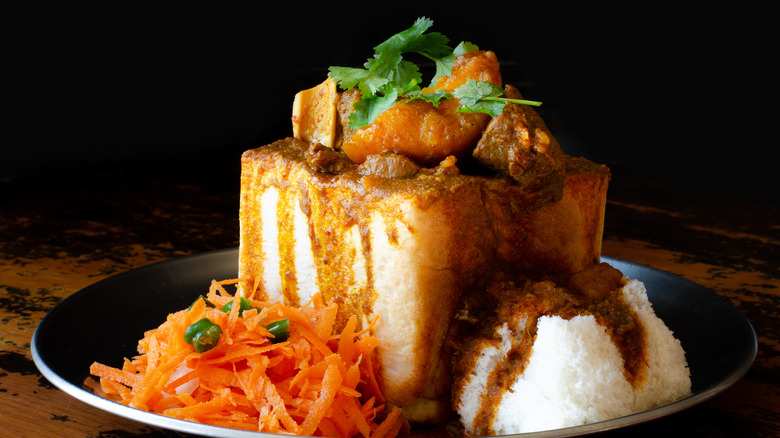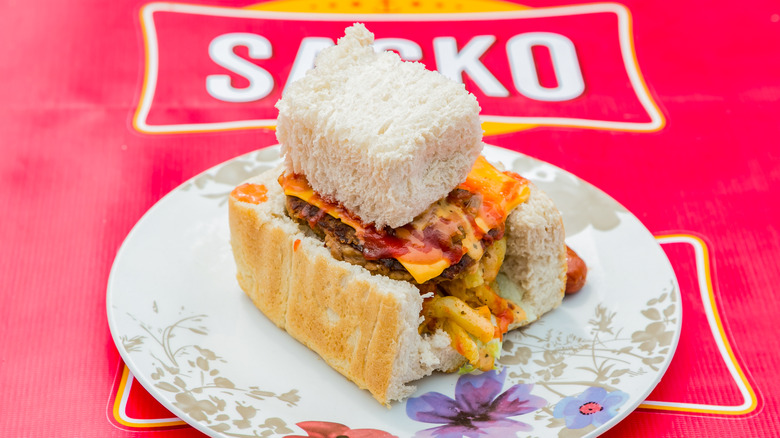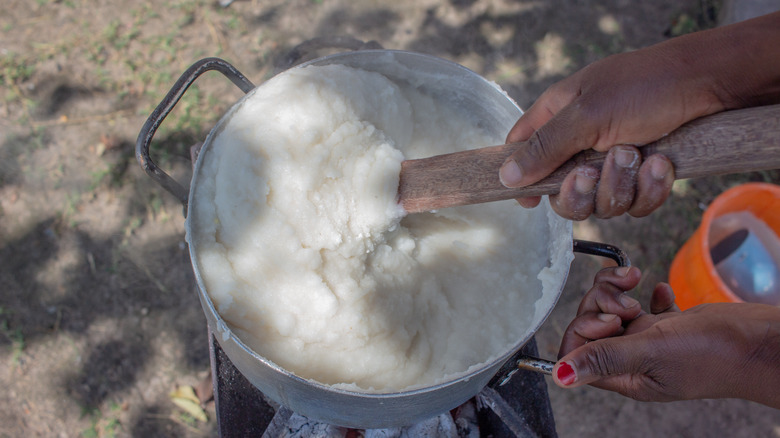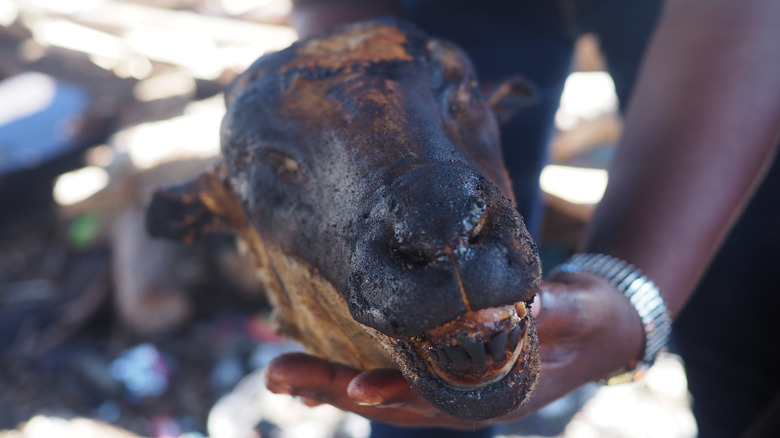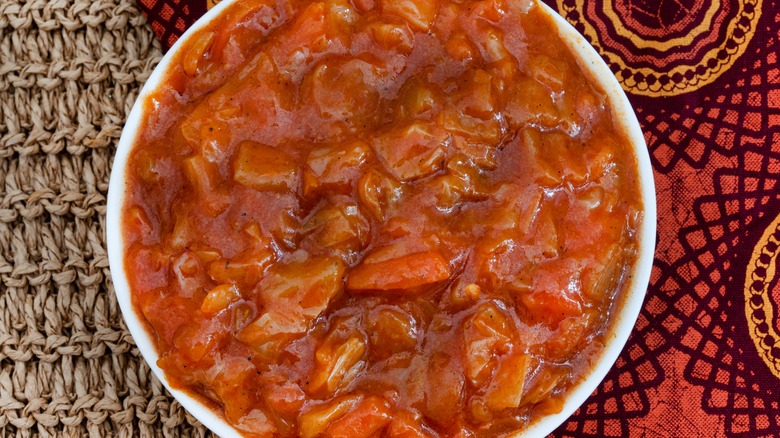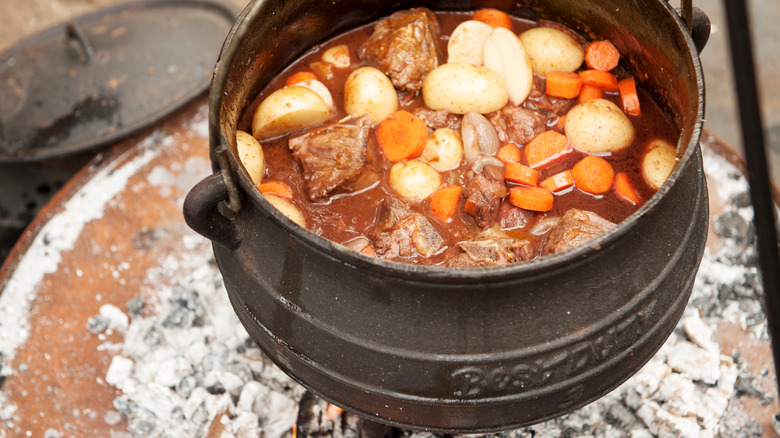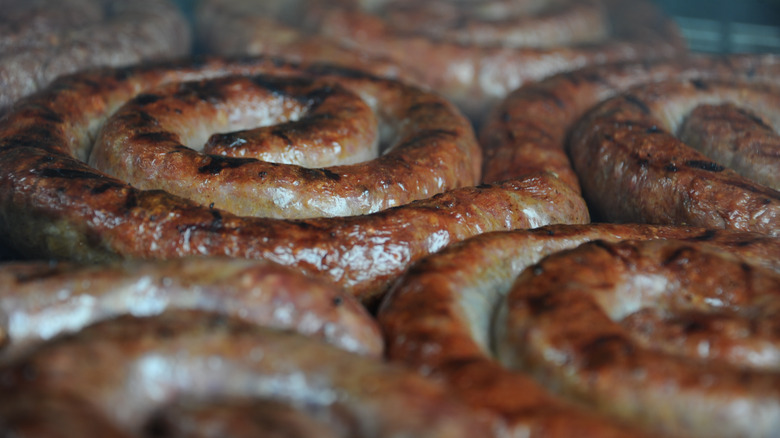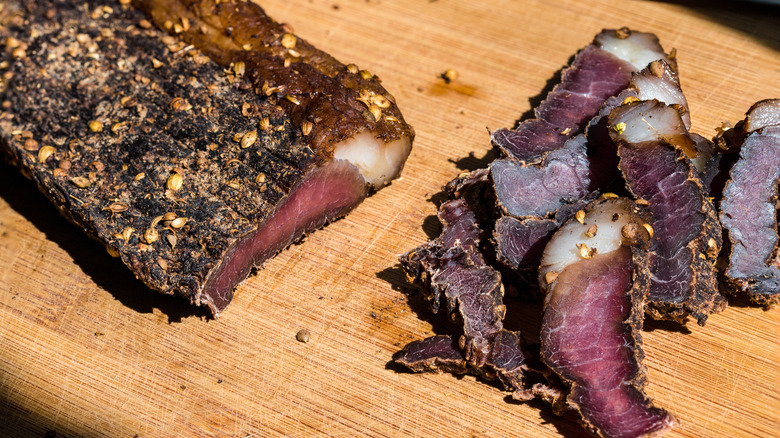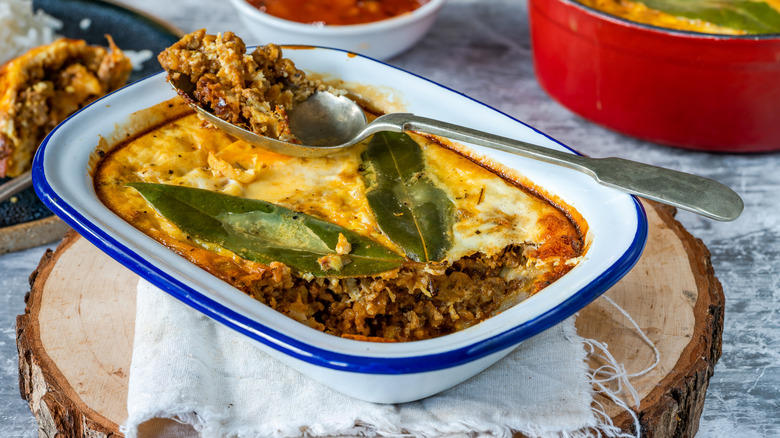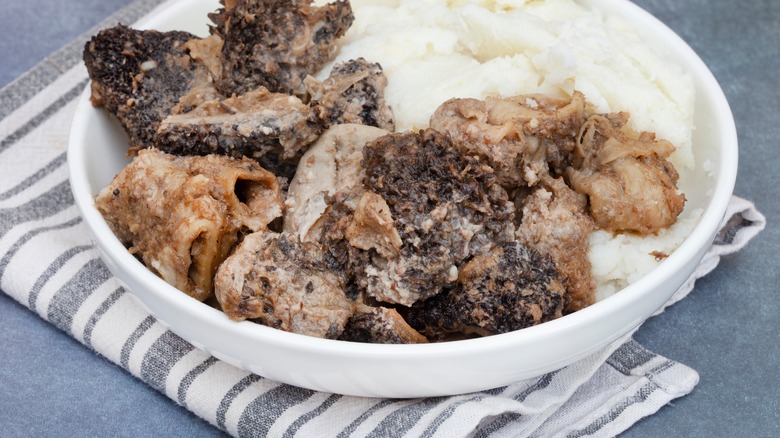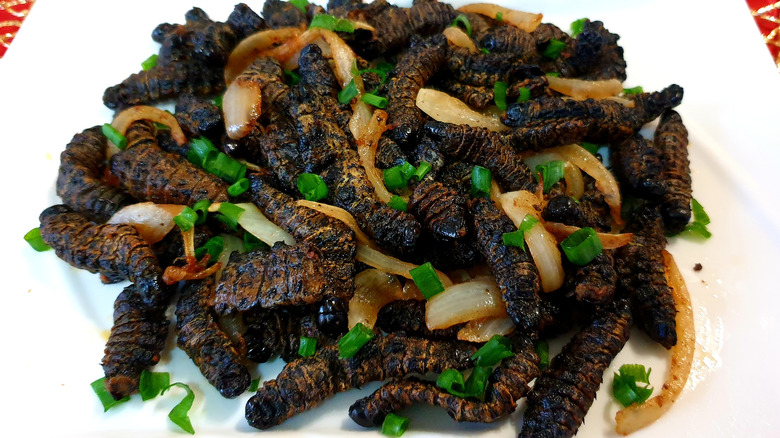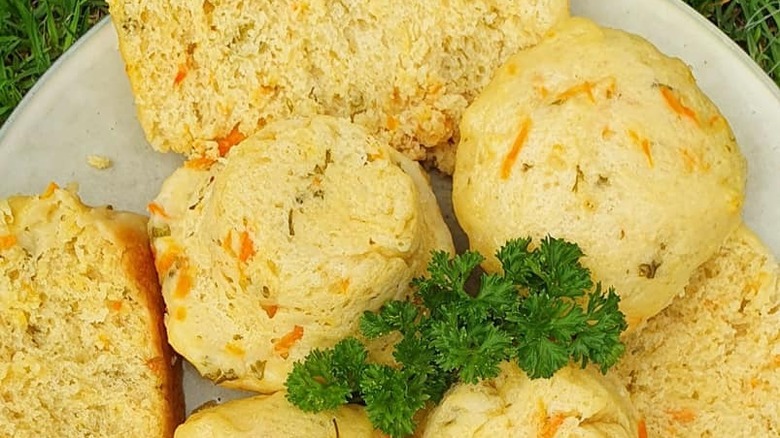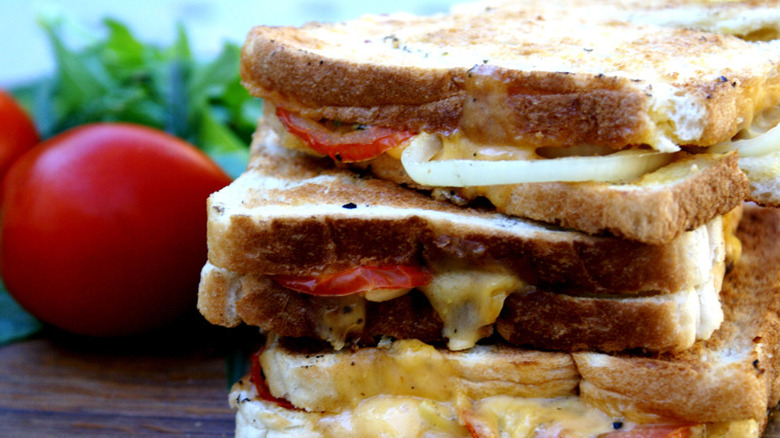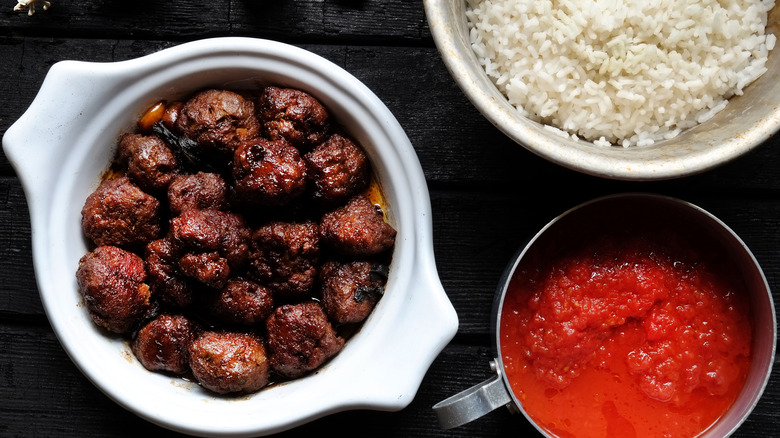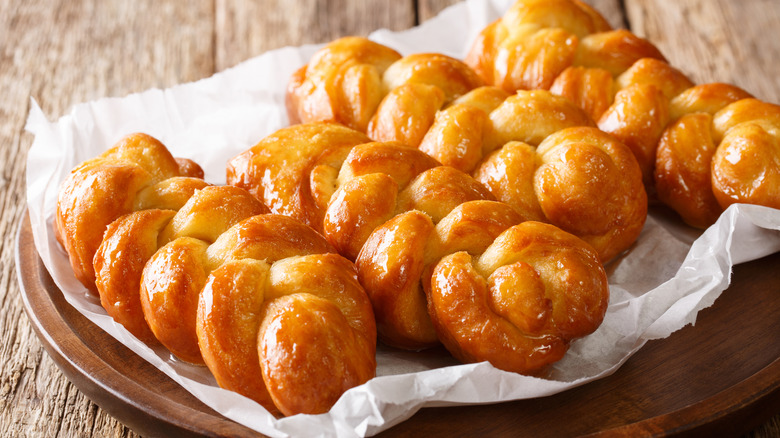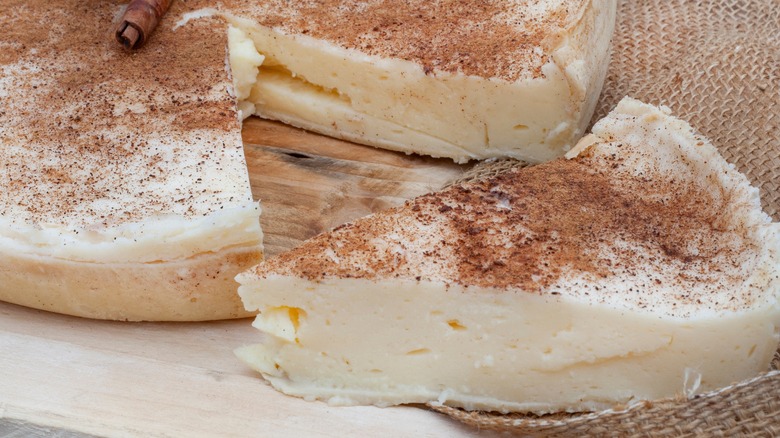The Best South African Foods You Probably Haven't Tried Yet
South African cuisine is influenced by cultures from all over the globe. The country is a mix of European, African, Indian, Asian, and other ethnic groups, all of whom have left their stamp on the national food scene (via South Africa Gateway). The story of the country's political history and colonial legacy is a tale both too long and too dark to be told in the introduction of a food article, but suffice it to say that the unique mix of people who settled in South Africa throughout its history (some of whom were brought to the country by force) created a food culture that is unlike any other on the face of the planet.
Although South African food resists generalizations, you will notice some recurring themes on this list. Many of the country's most famous dishes are meat-heavy, and South Africans love a good barbecue (or braai in Afrikaans). For this list, we tried to select a good mix of European, African, and Asian-influenced dishes to try to give a sense of the scope of South African cookery. Without further ado, here are some delicious South African foods you should seek out.
Bunny chow
Bunny chow is a confusingly-named food. It does not contain rabbit, nor is it food for rabbits. Instead, it's a hearty, portable lunch dish from Durban, a South African city with a large population of people of Indian descent. The word "bunny" in this context is actually an anglicization of "bania," the name given to Indian merchants in the early 20th century (via The Christian Science Monitor).
Per NPR, the first Indians arrived in Durban in the 1800s. They were made to work as indentured servants in sugar plantations by the British. Then another generation of Indian migrants came over and opened their own restaurants and shops. These "bania" merchants are credited with creating bunny chow, which is a fusion dish made by stuffing Indian-inspired curry into a hollowed-out loaf of white bread. The bread bowl turns the curry into a portable (if messy) finger food. Both vegetarian and meat-based curries are used for the filling in bunny chow.
Stories about why bunny chow was invented vary. According to The Christian Science Monitor, it was probably either made as a way to feed busy Indian laborers who wanted something to eat at work, or as a way to serve black diners who historically weren't allowed to eat inside Indian restaurants because of South Africa's racist laws. Either way, bunny chow is now a beloved staple in its home city eaten by people from all backgrounds.
Kota
A specialty of the South African townships, kota is similar in many ways to bunny chow. Its name comes from the fact that it's served on a quarter ("quarter" = "kota") of a loaf of bread. The bread is hollowed out and then stuffed with food to create a portable, handheld meal. Instead of curry, kotas are filled with french fries and a variety of meats, toppings, and sauces (via Eat Out).
The meats can include things like ham, Vienna sausage, and Russian sausage (a kind of smoked sausage), and you can often get multiple meats on the same kota. You can also add eggs and cheese if you want a truly overstuffed sandwich. After all the fillings are placed inside the hollowed-out loaf, the piece of the bread that was scooped out to make the hole gets tossed on top like a garnish. They definitely give you your money's worth at kota stands.
Per Forbes, the secret to eating a kota is to squeeze the sandwich inside of the plastic bag it's served in to keep all the fillings in place and make it easier to eat with your hands.
Pap
Most cultures have a starchy food that supplies (or historically supplied) the majority of the calories eaten by an average person (via National Geographic). In some places, the staple is rice, and in others, wheat or root vegetables form the base of the diet. In South Africa, corn is the most important staple food. Specifically, corn is consumed in the form of a cooked cornmeal dish known as pap (or mieliepap), according to South Africa's tourist website. Pap can be served for all meals and is cooked in many different ways to achieve different textures.
Per Life With Clotted Cream, pap is prepared differently depending on what it's going to be served with. For breakfast, it's cooked with a lot of water to make a thin porridge that's typically sweetened and buttered. If it's being served as a side for savory lunch or dinner dishes, it's usually cooked to a thicker consistency. Pap can even be turned into a fluffy, crumbly dish called krummel pap that looks kind of like cooked rice or couscous.
Smiley
Smileys actually smile back at you while you're eating them because they're whole, roasted sheeps' heads (via Taste Atlas). Per Gastro Obscura, smileys get their smile because of the way hair gets removed from the heads. The fur is burned off with hot metal rods, which tightens the skin and makes the sheep's mouth contort into something resembling a smile. The heads are roasted in metal drums and the meat is used in a variety of applications.
According to Taste Atlas, one of the most popular ways to serve Smileys is just to present the whole head with some salt and allow diners to tear the tender meat off of the skull with their hands. Gastro Obscura mentions that Smiley meat is also sometimes carved off of the bones and added to curries or braaied (barbecued). Although Smileys are popular because of their low cost, the head also contains some of the tastiest pieces of meat on the whole animal, including the tongue, cheeks, and eyes.
Chakalaka
Chakalaka's origins are hard to pin down, and the dish shows influences from many of the different cultural groups that settled in South Africa. National Geographic characterizes it as a riff on English baked beans remixed with input from Zulu, Indian, and Dutch cuisines. Recipes From a Pantry suggests that it might have been created by miners in Johannesburg and says it shows a Portuguese influence.
Either way, the dish starts with canned British-style baked beans. The beans get seasoned up with curry powder, tomatoes, other vegetables, and spices and herbs that vary from cook to cook. Grated carrots, diced bell peppers, and onions frequently join the party. Unlike baked bean dishes in America or Britain, chakalaka is meant to be served either cold or warm. It can be thought of as a side dish, a relish, a salad, or a condiment. It's a classic accompaniment to braaied meats.
Potjiekos
Potjiekos isn't so much a specific dish as it is a method of cooking. It generally consists of meat (traditionally wild game, though farmed meats are common these days), vegetables, and starches that are stewed together over a fire in a special pot called, naturally, a potjie (via Taste.com.au). This cast-iron pot set on three legs came from the Dutch and is a variant of the pot known as a Dutch oven in other parts of the world. Potjie is considered an Afrikaner dish (Afrikaners are South Africans descended from early Dutch and other European colonists).
The biggest difference between potjiekos and other types of stews is that potjiekos aren't stirred. Rather, the ingredients are set down in layers, starting with meat and then adding vegetables on top. This apparently helps keep the flavors of the different ingredients distinct from each other. Once the layers are constructed, everything simmers together in a flavorful liquid, often made with broth, wine, beer, or a combination thereof. The traditional open-fire cooking method gives potjiekos a smoky taste that most stews don't have.
Boerewors
The word "boerewors" means "farmer's sausage" in Afrikaans, the Dutch-based language spoken by Afrikaners (also known as Boers). Like the name, the food is also of Dutch origin and is based on Dutch sausage recipes. However, South African boerewors has its own unique seasoning profile that includes salt, pepper, cloves, nutmeg, and coriander. Like so many other South African specialties, it is a favorite at braais, and street vendors also grill this type of sausage over open fires. Boerewors is made with beef and must be at least 90% meat, a maximum of 30% of which can be fat. The beef is ground more coarsely than the meat you'll find in many other types of sausages. Instead of being packed into short links, it's typically stuffed into long lengths of intestine and then coiled into spirals (via Whetstone Magazine).
Although boerewors originated with the Dutch, it's now considered a classic part of South African cuisine and is cooked and eaten by all kinds of South African citizens. It's so important to the country's culture that it's regulated by the government, and rules like the meat percentages listed above are enshrined in law.
Biltong
Biltong is the South African answer to beef jerky. Both jerky and biltong are made with dried beef, but other than that basic fact, they are very different. While jerky is made by drying very thin pieces of lean seasoned beef, biltong is usually made from larger cuts. Biltong can be made with either lean or fatty beef, and it undergoes a curing process before it's dried (via Steak School).
Per Sowetan Live, the curing process involves marinating the meat in vinegar and spices overnight. After marinating, the meat is hung from hooks until dry. According to Steak School, the drying process takes longer with biltong than with jerky, and biltong is typically less tough than beef jerky is.
Once the meat has dried out, it's ready to eat. Since biltong is usually made with larger pieces of meat, it needs to be sliced into thin pieces for eating (via Stryve). Biltong generally has a strong beef flavor as well as a slight tang from the vinegar marinade. Biltong can also be made with wild game meats or ostrich instead of beef.
Bobotie
Bobotie is a dish made with minced meat mixed with fruit, curry powder, nuts, bread, and other seasonings, topped with an egg custard, and then baked until the top is golden brown and crusty (via The New York Times). It's typically made with lamb or beef. Bobotie is somewhat similar to Greek moussaka, though it's seasoned differently and contains less custard than moussaka typically does. The mix of fatty meat, spices, sweetness, and creaminess makes for a very complex flavor experience.
This dish has a very long and dark history. Its roots stretch back to when the Dutch first built a settlement in Cape Town, South Africa, to serve as a rest station for ships carrying spices from their colonies in Indonesia in the 1600s. Eventually the Dutch began enslaving Malay-speaking Indonesian people and bringing them to Cape Town as laborers. The spices and cooking techniques from Indonesia blended with Dutch traditions, and bobotie was born.
Mala mogodu
Tripe might not be a common feature on dinner menus in America, but cultures across the world have figured out delicious uses for cow stomach lining, from Mexico's menudo to Italy's trippa alla Romana. Many classic tripe recipes are stews that involve cooking tripe for hours until it transforms from tough and rubbery to soft and decadent. Mala mogodu is no exception.
Per Taste Atlas, mala mogodu is made with stewed tripe and often is seasoned with curry powder. It's usually served with some kind of starchy food like pap or dumplings to soak up the sauce, and sometimes contains chile peppers for a little heat.
This recipe from Woolworth's Taste calls for you to cook the tripe in water for an hour, rinse it, then cook it in fresh water for three more hours before combining it with the rest of the seasonings. The sauce contains canned tomatoes, garam masala (an Indian spice blend), paprika, chile pepper, and yogurt.
Mashonzha
Mashonzha, also known as mopane worms, are Emperor Moth caterpillars. They earned their name because they live in mopane trees. The caterpillars are collected en masse once or twice a year by shaking them out of the lower branches of the mopane trees. Once collected, they're preserved and used throughout the year (via eJozi's Recipe Book).
To preserve the caterpillars, workers first remove their guts, then dry them out. They're quite nutritious and contain lots of protein as well as some minerals. When used in recipes, they're typically soaked in water to rehydrate.
Mashonzha are a versatile ingredient. eJozi's Recipe Book has a recipe that involves stewing rehydrated worms in a spicy tomato sauce, but that's far from the only way they can be cooked. According to Daily News, in neighboring Zimbabwe, where they're also popular, mopane worms are sometimes eaten dry as a crunchy snack. Gastro Obscura says the caterpillars' flavor can vary from vegetal to meaty.
Dombolo
The word "Dombolo" is often translated to "dumpling," but this starchy food has more in common with bread than with American dumplings. It's made by steaming yeast-risen white bread dough in a pot of boiling water. According to African Food Network, Zulu cooks (Zulu people are one of South Africa's main ethnic groups), cook their dombolo in the same pot as the stew it will be served with, rather than in a separate pot as cooks from other backgrounds do.
Dombolo is often used as a starchy vehicle to mop up the juice from a stew, but it's also sometimes served sliced with butter, much like baked bread would be (via The South African). The same dough can be used to make small dumplings or to make a full-sized loaf of bread. Recipes vary; The South African recommends a very simple dough with just flour, water, yeast, and sugar, while African Food Network's recipe adds cornmeal and an egg.
Braaibroodjie
We've mentioned braais several times already, as barbecuing is one of the most beloved types of cooking in South Africa. When you think of a barbecue, your mind probably turns immediately to crackling, sizzling meats. There's plenty of that at typical South African braais, but there's one iconic braai dish that contains no meat at all: braaibroodjie (via Braai.com).
Braaibroodjie is a sandwich made with buttered white bread, cheddar cheese, sliced tomatoes, onions, and a schmear of chutney. It one-ups American grilled cheese by actually being cooked on a grill rather than in a pan or on a griddle. The sandwich needs to be cooked over relatively cool coals as the bread burns easily.
In a simple dish like this, the small details make all the difference. It's important to season the tomatoes with salt and pepper to get the best flavor. Per Saveur, the sweet-and-sour chutney is the component that makes this sandwich sing. In South Africa, a brand called Mrs. Ball's is the standard.
Frikkadels
In South Africa, it's typical to pack food to eat along the way when you go on a road trip. These provisions are known as padkos (via Focused Travels). Per FinGlobal, you typically stop somewhere in the middle of your trip to eat your padkos at a picnic table. One of the most popular padkos dishes is frikkadels, a type of meatball. Frikkadels are great road snacks because they can be eaten hot or cold.
Frikkadels are usually made with beef, but other than that, there's not much in common between the different recipes we found. FinGlobal's take on the dish, which is seasoned with sweet spices and served with gravy, looks similar to Swedish meatballs. A Cape Malay-style recipe infuses the meatballs with cilantro, coriander, garlic, and peppers. The frikkadels from WhatsForDinner are more like Italian-American meatballs. They're seasoned with herbs and served with tomato sauce. However they're made, it's hard to argue with a good meatball, and we can see why frikkadels are such a popular snack/meal.
Koeksisters
Koeksisters are basically the South African version of donuts. According to African Bites, the Afrikaner version of this treat is made using a baking powder-leavened wheat dough that's enriched with butter, eggs, and milk. The dough is rolled out, cut into strips, and then the strips are braided to create koeksisters' traditional shape. Then the dough is deep-fried and soaked in a lemony sugar syrup to give the koeksisters sweetness and a glossy appearance. Per SA Promo, the syrup needs to stay cold in order to keep the deep-fried treats crispy.
This fried treat is a classic street food snack in South Africa. While the Afrikaner version is very popular, there's also a Cape Malay version. Cape Malay koeksisters are also made with deep-fried dough, but other than that they're very different from their Afrikaner cousins. The dough is yeast-risen and flavored with cinnamon and anise. The syrup is brown sugar-based, and the donuts get tossed in dried coconut after their syrup bath (via The South African).
Melktert
Melktert, or milk tart, is an Afrikaner dish from the Cape of Good Hope region. As its name suggests, melktert is a milk-based custard pie, usually flavored with cinnamon (via Gastro Obscura).
According to IOL, the traditional crust for melktert is short-crust pie dough, but these days crustless versions and tarts made with frozen puff pastry are also popular. The filling is generally made with milk, eggs, sugar, and some kind of starch to thicken it up.
Dairy farming was a popular profession among early Dutch settlers on the Cape, so it makes sense that they would come up with a dessert that used a lot of milk. Melktert's history stretches back even before the Dutch arrived in South Africa, however. Per the Weekend Argus, medieval Dutch cooks made similar pastries, and a Dutch cookbook from 1510 has a recipe that many see as the predecessor to modern milk tarts. The dish is so popular in South Africa that you can buy milk tart-flavored products like milkshakes, alcohol, and croissants.
